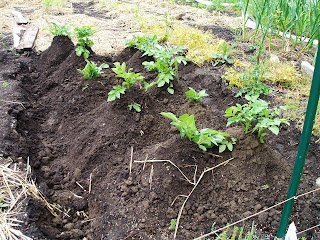When a garlic plant grows, there are two delicious parts: the garlic bulb, which is found under the soil, and the garlic scape, which is this long, round, sometime twirly stalk that protrudes from the top center of the plant. Picking off this scape allows the plant to dedicate all of its energy to producing the garlic bulb--and the scapes can also be used for food. Scapes have a subtle garlic flavor when cooked, and a pretty powerful garlic flavor when raw. Chopped finely in stir-fries, they're delicious. Or, made into pesto...
the garlic plant; the scape is the cylindrical stalk that loops around
I made six cups of pesto with garlic scapes, olive oil, almonds, and a little bit of nutritional yeast. It was a bit of a process because the blender I borrowed from Dining Services doesn't function nearly as well as a food processor does...
Left: blending, Right: the final product (mm!)
I saved a small amount to eat immediately (above right), the rest is frozen for use in the fall, or later in the summer
We're also growing potatoes in the presidential garden in tire-stacks and in the ground. Because potatoes benefit from being "mounded", or covered with dirt as they grow, growing them in tires allows more (easy!) mounding, and therefore more potatoes. The only silly decision on the part of WSG was deciding to place these tire stacks at the presidential garden, so that we now have to wheelbarrow our compost up to the presidential garden to fill the tire stacks. They're growing really well, though! Potatoes are ready to harvest as "new potatoes" once the tops of plants flower. They can be harvested full size when the tops of the plants dry and turn brown.
potatoes in tire stacks
potatoes in the ground, at the presidential garden
the presidential garden


















